Papers by Bogusław Pawłowski
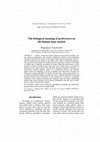
Anthropological Review, 2000
Factors, which universally influence mate choice decisions, are: age, physical appearance, and re... more Factors, which universally influence mate choice decisions, are: age, physical appearance, and resources. Different evidence of the biological relevance of these three factors on the human mate market is presented. The sexspecific preferences for partner.s age reflect such values as Fisherian reproductive potential and fecundity for females and life expectancy related to the length of further time of paternal investment for males. Physical attractiveness is analyzed as a marker of female.s age, and in the case of both sexes as a marker of hormone level, heterozygosity and therefore immunocompetence. Because attractiveness connotes genetic quality of a prospective partner and indicates higher fitness for offspring, it is not an arbitrary trait. Resources of males are discussed as being important for females because they assure good paternal investment and therefore higher reproductive success. Human flexibility in age and physical attractiveness preferences is also examined in relati...

PLOS ONE, 2021
Physical attractiveness has been shown to reflect women’s current fecundity level, allowing a man... more Physical attractiveness has been shown to reflect women’s current fecundity level, allowing a man to choose a potentially more fertile partner in mate choice context. However, women vary not only in terms of fecundity level at reproductive age but also in reproductive longevity, both influencing a couple’s long-term reproductive success. Thus, men should choose their potential partner not only based on cues of current fecundity but also on cues of reproductive longevity, and both may be reflected in women’s appearance. In this study, we investigated if a woman’s facial attractiveness at reproductive age reflects anti-Müllerian hormone (AMH) level, a hormone predictor of age at menopause, similarly as it reflects current fecundity level, estimated with estradiol level (E2). Face photographs of 183 healthy women (Mage = 28.49, SDage = 2.38), recruited between 2nd - 4th day of the menstrual cycle, were assessed by men in terms of attractiveness. Women’s health status was evaluated base...
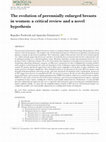
Biological Reviews, 2021
ABSTRACTThe possession of permanent, adipose breasts in women is a uniquely human trait that deve... more ABSTRACTThe possession of permanent, adipose breasts in women is a uniquely human trait that develops during puberty, well in advance of the first pregnancy. The adaptive role and developmental pattern of this breast morphology, unusual among primates, remains an unresolved conundrum. The evolutionary origins of this trait have been the focus of many hypotheses, which variously suggest that breasts are a product of sexual selection or of natural selection due to their putative role in assisting in nursing or as a thermoregulatory organ. Alternative hypotheses assume that permanent breasts are a by‐product of other evolutionary changes. We review and evaluate these hypotheses in the light of recent literature on breast morphology, physiology, phylogeny, ontogeny, sex differences, and genetics in order to highlight their strengths and flaws and to propose a coherent perspective and a new hypothesis on the evolutionary origins of perennially enlarged breasts in women. We propose that b...
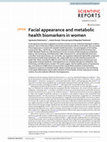
Scientific Reports, 2020
Facial appearance has been suggested to provide an honest cue of an individual’s biological condi... more Facial appearance has been suggested to provide an honest cue of an individual’s biological condition. However, there is little direct evidence that facial attractiveness reflects actual health. Here we tested if facial appearance is related with metabolic health biomarkers. Face photographs of 161 healthy, young women (Mage = 28.59, SDage = 2.34) were assessed in terms of perceived attractiveness and health. Metabolic health was evaluated based on levels of markers of lipid and glucose metabolism balance, liver functioning, and inflammation. BMI, testosterone (T), and estradiol (E2) levels were controlled. Facial attractiveness, but not health, was negatively related with lipid profile components detrimental to health (total cholesterol, LDL, triglycerides) but not with relatively protective for health HDL. When controlled for BMI, E2, and T, only the relationship between attractiveness and triglycerides remained significant. Facial appearance was unrelated with glucose metabolism,...
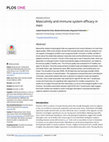
PLOS ONE, 2020
Masculinity-related morphological traits are supposed to be honest indicators of a man's biol... more Masculinity-related morphological traits are supposed to be honest indicators of a man's biological quality. While some studies showed that sexually dimorphic traits are related to various aspects of biological condition such as general health, immunity or fertility, still little is known about the relationship between masculine traits and the effectiveness of innate and adaptive immunity in humans. The aim of this study was to see if masculine traits, which are dependent on androgen levels in foetal and pubertal stages of development, are related to the immune quality in healthy men. The immune quality was evaluated for 91 healthy men aged 19–36 years. Immunity measurements included innate and adaptive parameters. General health status, age, testosterone level, BMI, physical activity, and smoking were controlled. The shoulder-to-hip ratio (SHR), 2D:4D digit ratio and hand-grip strength (HGS) were used as markers of masculinization. The regressions showed that when controlling f...
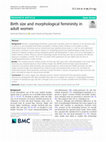
BMC Evolutionary Biology, 2020
BackgroundWomen’s morphological femininity is perceived to develop under the influence of sex hor... more BackgroundWomen’s morphological femininity is perceived to develop under the influence of sex hormones and to serve as a cue of estradiol level, fertility and health in mating context. However, as the studies on direct relationship between femininity and sex steroid levels have reported mixed results, it is still not well understood what factors contribute to inter-women variation in morphological femininity. Epidemiological studies show that indicators of adverse conditions during intrauterine growth and development in utero, such as low birthweight or relative thinness at birth, influence women’s physiology ovarian functioning and may be associated with life-time exposure to estradiol in women. Thus, here we tested if birth parameters are also related with the level of morphological femininity in adult women.ResultsOne hundred sixty-five healthy women of mean age 28.47 years (SD = 2.39) participated in the study. Facial femininity was estimated based on facial width-to-height rati...

Psihologijske teme, 2017
Previous studies have documented links between sub-clinical narcissism and the active pursuit of ... more Previous studies have documented links between sub-clinical narcissism and the active pursuit of short-term mating strategies (e.g., unrestricted sociosexuality, marital infidelity, mate poaching). Nearly all of these investigations have relied solely on samples from Western cultures. In the current study, responses from a cross-cultural survey of 30,470 people across 53 nations spanning 11 world regions (North America, Central/South America, Northern Europe, Western Europe, Eastern Europe, Southern Europe, Middle East, Africa, Oceania, Southeast Asia, and East Asia) were used to evaluate whether narcissism (as measured by the Narcissistic Personality Inventory; NPI) was universally associated with short-term mating. Results revealed narcissism scores (including two broad factors and seven traditional facets as measured by the NPI) were functionally equivalent across cultures, reliably associating with key sexual outcomes (e.g., more active pursuit of short-term mating, intimate par...
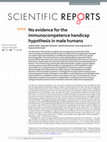
Scientific reports, Jan 9, 2018
The observations that testosterone might be immunosuppressive, form the basis for the immunocompe... more The observations that testosterone might be immunosuppressive, form the basis for the immunocompetence handicap hypothesis (ICHH). According to ICHH only high-quality individuals can maintain high levels of testosterone and afford the physiological cost of hormone-derived immunosuppression. The animal and human studies that attempted to support the ICHH by precisely defined impairment of immunity associated with high testosterone levels are inconclusive. Furthermore, human studies have used only selected immune functions and varying testosterone fractions. This is the first study examining the relationship between multiple innate and adaptive immunity and serum levels of free testosterone, total testosterone, DHT and DHEA in ninety-seven healthy men. Free testosterone and marginally DHT levels were positively correlated with the strength of the influenza post-vaccination response. Total testosterone and DHEA showed no immunomodulatory properties. Our findings did not support ICHH as...
Evolutionary Psychology, 2009
Proceedings of the National Academy of Sciences, 2016
Significance Pathogens, and antipathogen behavioral strategies, affect myriad aspects of human be... more Significance Pathogens, and antipathogen behavioral strategies, affect myriad aspects of human behavior. Recent findings suggest that antipathogen strategies relate to political attitudes, with more ideologically conservative individuals reporting more disgust toward pathogen cues, and with higher parasite stress nations being, on average, more conservative. However, no research has yet adjudicated between two theoretical accounts proposed to explain these relationships between pathogens and politics. We find that national parasite stress and individual disgust sensitivity relate more strongly to adherence to traditional norms than they relate to support for barriers between social groups. These results suggest that the relationship between pathogens and politics reflects intragroup motivations more than intergroup motivations.

acta ethologica, 2016
Mate value discrepancy (MVD) between heterosexual partners is an important factor influencing rel... more Mate value discrepancy (MVD) between heterosexual partners is an important factor influencing relationship satisfaction which, in turn, has an effect on the quality and the stability of the relationship. Therefore, partners' involvement in mate retention behaviours, such as controlling behaviours, can be related to MVD and our study aims to determine whether such an association exists. In order to do so, we analysed female perception of MVD and their opinion regarding the intensity of controlling behaviours performed by themselves as well as their romantic partners. Female perception of the intensity of controlling behaviours performed by both partners was the highest in couples where a woman assesses her own mate value (MV) as higher than her partner's MV and significantly different than in relationships where male MV exceeded those of the female. Our study also indicates that MVD should be taken into account when analysing sex differences in intensities of mate retention behaviours. Finally, we provide evidence supporting the significance of the relationship length for controlling behaviour intensity. Findings are discussed within an evolutionary perspective.

Collegium antropologicum, 2011
The possible existence of a relationship between breastfeeding duration, educational status and w... more The possible existence of a relationship between breastfeeding duration, educational status and waist-hip ratio (WHR) as a measure of fertility and biological fitness in a sample of the Polish population is examined in this article. Data on age, height, weight, waist and hip circumferences, educational level (as a proxy for socio-economic status), and duration of breast feeding were collected for women using questionnaires in 11 outpatients' surgeries for healthy children, and in 5 general practices in three districts of Wroclaw, Poland. An ordinal multinominal linear model with logit link was used to determine the extent to which duration of lactation was influenced by maternal WHR and level of education. The best single predictor for the duration of lactation was WHR. While WHR decreases according to increasing duration of lactation for mothers with university or high school education, no such differences were observed among women at the lowest level of education. This study c...
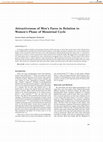
Collegium antropologicum, 2006
In between-subjects studies on two groups of women of the same age, we show that women assess mal... more In between-subjects studies on two groups of women of the same age, we show that women assess male's facial attractiveness differently in the follicular (F) and luteal (L) phases. In the high conception risk phase (F), women tended to give higher scores to male faces than when they were in the luteal phase. During the five first days of the cycle, i.e. when the estrogen level is still low, women assessed men's facial attractiveness relatively highly. We suggest that it is progesterone in the luteal phase that is responsible for lower attractiveness assigned then to male faces. We also tested which anthropometric facial traits or indices influence male attractiveness. We found that assessments of attractiveness were correlated only with mouth height (positively) and the angle between the middle of the mouth and the middle of the eyes (negatively). The results are compared with those from other studies and discussed in the light of evolutionary biology.

Collegium antropologicum, 2008
In order to test the assumption that female attractiveness relates to reproductive success, photo... more In order to test the assumption that female attractiveness relates to reproductive success, photographs of 47 rural Polish women taken in their youth were rated for attractiveness, and BMI at age 18 was recorded; these measures of attractiveness were then compared with their subsequent life histories. Facial attractiveness did not relate to number of children or grandchildren. It also did not relate to age of marriage or husband's education. It did relate to number of marriages and husband's height. BMI at age 18 did not relate significantly to any of the outcome variables. These results suggest that although more attractive women may have married higher quality (taller) husbands and may in ancestral population have achieved greater reproductive success this way, there is no evidence in a modern, European Catholic society for their having greater reproductive success.
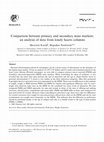
Personality and Individual Differences, 2003
Personal advertisements placed in newspapers can be a good source of information on the dynamics ... more Personal advertisements placed in newspapers can be a good source of information on the dynamics of the human mate market. From an analysis of 1587 (776 female and 811 male) advertisements placed in the local Lower Silesian (Poland) newspaper, we were able to compare primary (never married) (PMM) and secondary (divorced/separated) (SMM) mate markets. When controlling for place of residence, it was revealed that the mean time span between the end of education and the age at which females resort to personal advertisement (7-8 years) is very similar in the three education categories. Men who graduated from high school or university were over-represented on the SMM. There were no differences in the residuals of height, weight or BMI between PMM and SMM for females and significant difference only for men's height with relatively taller men on the SMM for the combined two lower levels of education. We also compared PMM and SMM separately for men and women in terms of the rates of offering and seeking resources, attractiveness, commitment and social skills. PMM and SMM differ in three such categories for men and in four for women. However when controlling for advertiser's age, there were only two differences for women (resources were sought for and attractiveness offered more often on the SMM) and one for men (commitment was sought more frequently on the SMM). This indicates that the difference in preferences should be attributed mainly to the age of subjects and only to a smaller extent to the type of mate market (PMM vs SMM).

Personality and Individual Differences, 2008
Physical stature plays an important role in human mate choice because it may signal dominance, hi... more Physical stature plays an important role in human mate choice because it may signal dominance, high status, access to resources, and underlying heritable qualities. Although past research has examined overall preferences for height, we propose these preferences are modified by evolved mechanisms that consider one's own height and prevailing social norms. We examined this proposal using samples of 2000 personal ads and 382 undergraduates. Both sexes preferred relationships where the woman was shorter when specifying the shortest acceptable, tallest acceptable, and ideal dating partner. In the personal ads sample, this norm was more strongly enforced by women than by men: 23% of men compared to only 4% of women would accept a dating relationship where the woman was taller. Preferences for the male-taller norm were less pronounced in short men and tall women, who shifted towards preferring someone closer to their own height. This limited their potential dating pool but ensured they would select a mate within the typical range of variation for height. Surprisingly, endorsement of traditional gender role norms was only weakly related
Hormones and Behavior, 2012
This article appeared in a journal published by Elsevier. The attached copy is furnished to the a... more This article appeared in a journal published by Elsevier. The attached copy is furnished to the author for internal non-commercial research and education use, including for instruction at the authors institution and sharing with colleagues. Other uses, including reproduction and distribution, or selling or licensing copies, or posting to personal, institutional or third party websites are prohibited. In most cases authors are permitted to post their version of the article (e.g. in Word or Tex form) to their personal website or institutional repository. Authors requiring further information regarding Elsevier's archiving and manuscript policies are encouraged to visit: http://www.elsevier.com/copyright
Evolution and Human Behavior, 2007
This study investigated sexual imprinting in human females. Facial proportions of fathers were co... more This study investigated sexual imprinting in human females. Facial proportions of fathers were compared to the proportions of stimulus faces the participants found attractive. Women who rated their childhood relationships with their father highly showed a significantly stronger relationship between the proportions of their father's face and their chosen stimulus than other women, primarily concerning the central face area. Women who rated their fathers less highly did not show similarity between fathers' and stimulus' faces. This supports previous research using photographs of parents' and spouses' faces.

Evolution and Human Behavior, 2008
Mate preferences are condition dependent (i.e., females in better biological condition might be m... more Mate preferences are condition dependent (i.e., females in better biological condition might be more demanding with respect to fitnessrelevant male traits). Such traits usually indicate male biological quality or ability to secure resources that could be invested in offspring. Here we study female preferences for male resources, commitment, attractiveness, good sense of humor, and sensuality (when seeking both longterm and short-term partners) in relation to women's morphological traits such as height, weight, waist and hip girth, body mass index (BMI), and waist-to-hip ratio (WHR). We show that preferences for resources and attractiveness do indeed depend on women's phenotype. Women with relatively lower WHR and BMI more strongly prefer resources in a potential long-term partner than those with higher WHR and BMI. However, when controlling for age, place of residence, and whether they have had children, it is WHR (but not BMI) that influences female preference for resources and attractiveness. Women with higher WHR (those who, according to many studies, are considered as less attractive) are more prone to prefer physical attractiveness in a potential long-term partner. Furthermore, despite commitment having received the highest score in a long-term context, the preference for this trait in a potential partner was not related to women's body morphology. We suggest evolutionary and proximate explanations for such condition-dependent preferences.











Uploads
Papers by Bogusław Pawłowski